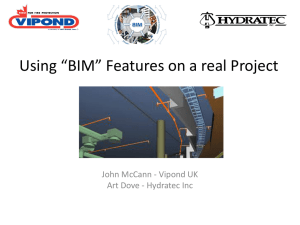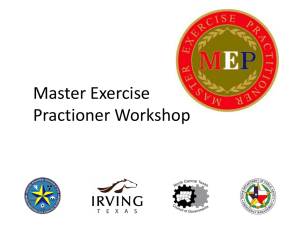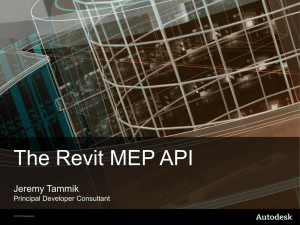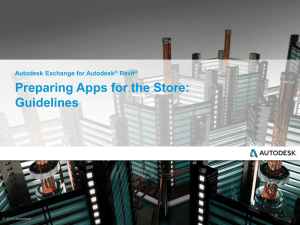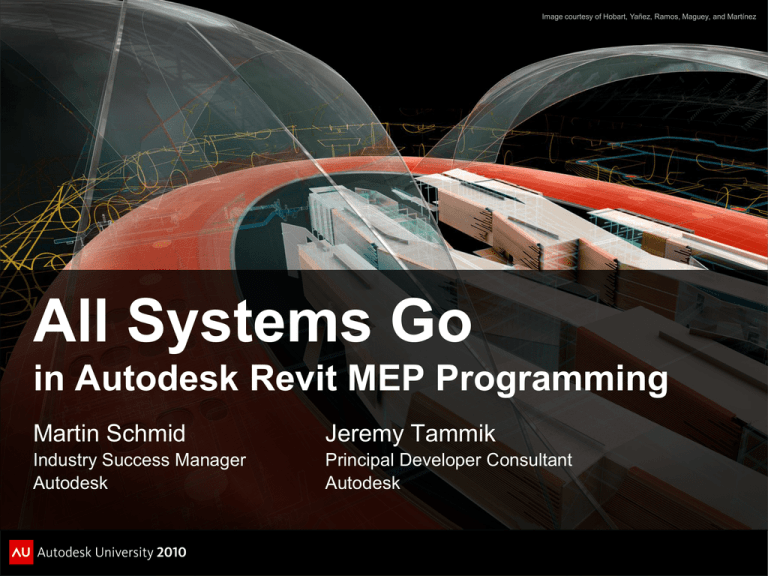
Image courtesy of Hobart, Yañez, Ramos, Maguey, and Martínez
All Systems Go
in Autodesk Revit MEP Programming
Martin Schmid
Jeremy Tammik
Industry Success Manager
Autodesk
Principal Developer Consultant
Autodesk
Objectives of this RME API Unconference
Share and discuss best practices of Revit MEP programming
You should be familiar with
Your current areas of interest and hottest problems
Your ideas and visions
Your experience
Wish list items
Programming for MEP in a BIM
The functionality of the Revit MEP API
The Revit MEP API samples
We do not discuss and assume knowledge of
How to program in .NET
The basics of the generic Revit API
Revit product and Revit MEP usage
About the Presenters
Martin J. Schmid P.E.
Industry Success Manager
Autodesk
Martin has worked on-site with customers to implement best practices using AutoCAD
MEP and Revit MEP, ranging from engineering firms and manufacturers to 3rd party
developers. In his current role as Industry Success Manager, Martin works with product
management, product design, and quality assurance teams providing subject matter
expertise. In addition, he works with sales and key accounts to help with workflow
adoption and to identify technical trends. He has written and presented material on
AutoCAD MEP and Revit MEP to coworkers as well as at Autodesk University. Prior to
involvement with the development of MEP products, Martin worked in a variety of roles
in a number of architecture and engineering firms, including electrical designer,
engineering coordinator, and application developer. Martin has a master’s degree in
Architectural Engineering from Kansas State University and a master’s in Business
Management of Technology from the University of Texas in San Antonio, and is a
member of ASHRAE. Martin is a published co-author of books on AutoCAD MEP and
Revit MEP. Martin has a beautiful wife and two daughters, and works from his home in
San Antonio, TX. Martin has two drum sets which get to use during ‘down time’, and
enjoys travelling and reading.
About the Presenters
Jeremy Tammik
Principal Developer Consultant
Developer Technical Services
EMEA, Autodesk SARL
Jeremy is a member of the AEC workgroup of the Autodesk Developer Network ADN
team, providing developer support, training, conference presentations, and blogging on
the Revit API.
He joined Autodesk in 1988 as the technology evangelist responsible for European
developer support to lecture, consult, and support AutoCAD application developers in
Europe, the U.S., Australia, and Africa. He was a co-founder of ADGE, the AutoCAD
Developer Group Europe, and a prolific author on AutoCAD application development.
He left Autodesk in 1994 to work as an HVAC application developer, and then rejoined
the company in 2005.
Jeremy graduated in mathematics and physics in Germany, worked as a teacher and
translator, then as a C++ programmer on early GUI and multitasking projects. He is
fluent in six European languages, vegetarian, has four kids, plays the flute, likes
reading, travelling, theatre improvisation, yoga and carpentry, loves mountains,
oceans, sports, and especially climbing.
The Revit MEP API
Introduction
Analysis
Hierarchical Systems and Connectors
Electrical
HVAC and Plumbing
Sample Applications
Learning More
Acronyms
ADN
AEC
API
BIM
GUI
HVAC
MEP
RAC
RME
RST
SDK
UI
Autodesk Developer Network
Architecture, Engineering, Construction
Application Programming Interface
Building Information Model
Graphical User Interface
Heating, Ventilation, and Air Conditioning
Mechanical, Electrical, and Plumbing
Revit Architecture
Revit MEP
Revit Structure
Software Development Kit
User Interface
MEP Application Requirements
Mechanical, electrical and plumbing domains
M is HVAC, i.e. heating, ventilation and air conditioning
Need for strong model analysis tools
Need to read and write access to the components and data
MEP project information
Green Building XML, gbXML
Spaces and zones
Electrical systems, components, properties and parameters
Duct and pipe systems, components, properties and parameters
Element creation and modification
System traversal and analysis
The Generic Revit API
Basic Revit API is generic
All flavours use the same .NET assembly RevitAPI.dll
Specific additional features exist for each flavour, e.g.
Room-related functionality in Revit Architecture
Access to the analytical model in Revit Structure
Access to the MEP model in Revit MEP
Revit MEP API Evolution
Generic element and parameter access can always be used
Revit 2008 provided no MEP-specific API
Revit 2009 introduced MEP-specific API support
MEP model property, space and zone, electrical and mechanical
equipment, lighting device and fixture, connector, electrical system
MEP API was a focal point of the Revit 2010 and 2011 APIs
2010: MEP namespace, support for HVAC and piping systems
2011: conduit, cable tray, panel schedule and more
Revit MEP 2011 Product Enhancements
Panel Schedules
Cable Tray and Conduit
Other Enhancements
Placing Valves and Fittings in Section or Elevation Views
Tagging of MEP Elements during placement
Demand Factors and Load Categories
Piping Companion Flanges
New Electrical Content
Oval Duct
Revit MEP 2011 API Enhancements
Cable Tray and Conduit
CableTrayConduitBase – base class for cable trays and conduits
CableTrayConduitRunBase – base class for cable tray and conduit runs
CableTray – a cable tray instance
CableTrayType – a cable tray type
CableTrayRun – a cable tray run
Conduit – a conduit instance
ConduitType – a conduit type
ConduitRun – a conduit run
Panel Schedules
TableView – represents a view that shows a table
TableData – holds most of the data describing the table row, column, and cell
TableSectionData – holds row, column and cell data for a TableData instance
PanelScheduleView – represents a view that shows a panel schedule
PanelScheduleData – holds most of the layout, appearance, row, column, and cell style data
PanelScheduleTemplate – represents a branch panel, a switchboard or a data panel template
PanelScheduleSheetSegment – represents a segment of a panel schedule sheet instance
PanelScheduleSheetInstance – represents an instance of a panel schedule placed on sheet
Other Enhancements
EnergyDataSettings
Validation in ElectricalSystem Properties
WireMaterialType, InsulationType, TemperatureRatingType
DuctConnector, PipeConnector, ElectricalConnector
Demand Factor and Load Classifications
Analysis
MEP Project Info and EnergyDataSettings
EnergyDataSettings class manages MEP project info
Access via EnergyDataSettings.GetFromDocument method
For project location use Document.ActiveProjectLocation
Green Building XML export
Document.Export(
string folder,
string name,
GBXMLExportOptions );
Spaces and Zones
Revit 2009 improved workflow between Architecture and MEP
Previously, MEP user had to Copy/Monitor rooms from architect
Architectural rooms are unsuitable for MEP analysis
MEP uses space instead of room, and zone to manage spaces
Rooms can be subdivided into exterior and interior subspaces
AddSpaceAndZone SDK sample
Wrong height, often too large for analysed region
Programmatic creation and management of spaces and zones
FamilyInstance class has Room and Space properties
FamilyInstance fi; // get a family instance
Space space = fi.Space; // query its space
Space space2 = fi.get_Space( phase ); // query space in given phase
Model Inspection Utilities
Enable component location, space adjacency analysis, etc.
Volumes, rooms and spaces
FamilyInstance.Space determines space containing family instance
Room.IsPointInRoom determines if a point is in a room volume
Space.IsPointInSpace determines if a point is in a space volume
GetRoomAtPoint and GetSpaceAtPoint return room or space
containing point
Ray intersection
FindReferencesByDirection shots a ray through the model
Given a starting point and direction vector
Returns an array of references of intersected elements and faces
AvoidObstruction, FindColumns, MeasureHeight, and
RayTraceBounce SDK samples
Connectors and
Hierarchical Systems
Hierarchical System Structure and MEP Model
MEP systems consist of hierarchically connected components
Many components are represented using family instances
Connectors can link neighbouring components and transfer info
System classes
ElectricalSystem
MechanicalSystem
PipingSystem
Family instance provides MEPModel property
MEPModel has ConnectorManager and ElectricalSystems properties
Derived classes include ElectricalEquipment, LightingDevice,
LightingFixture, MechanicalEquipment, MechanicalFitting
Connectors
Connector class
Used to represent connections
in the Revit BIM project context
Part of MEP component, not independent Revit database element
Logical connectors
Physical connectors
Used in electrical domain
Cables and wires are possibly not specified
Enables traversal of connected electrical system hierarchies
Connect neighbouring components physically
Transmit sizing dimensions and flow information
Family editor connection elements
Independent elements for defining connectors
Used to model library parts in family context
Specialised derived classes for duct, pipe and electrical connectors
Electrical
Electrical System Hierarchy
Three-tier recursive hierarchy, cf. electrical system browser
Panel > systems or circuits > circuit elements, may be panels
Logical connections between components
Wires are annotation elements
System can be traversed through connectors
Connectivity information also available in element parameters
MEP electrical sample application demonstrates traversal using
both MEP connectors and generic parameters (much harder)
Revit SDK PowerCircuit sample shows creation and editing
HVAC and
Plumbing
HVAC and Piping Hierarchy
Systems manage the top level system properties
Ducts and pipes define the main flow elements
Fittings implement bends and branches in the system
Connectors hook up the ducts, pipes and fittings
Systems
Revit 2010 classes MechanicalSystem and PipingSystem
Access to equipment, connectors and system type
Access to system properties such as flow and static pressure
DuctNetwork and PipeNetwork properties access system
contents
Ducts and fitting elements in no particular order
Does not include terminals or equipments
Query connector managers for traversal in flow direction
TraverseSystem SDK sample
Duct and Pipes
Represented by Duct, FlexDuct, Pipe and FlexPipe classes
Provide read access to duct properties, types, and geometry
Change duct or pipe type
Move duct or pipe
Derived from MEPCurve
Use Move method rather than Location
Layout duct or pipe
Driven by two points, point and connector, or two connectors
Fittings
Represented by standard RFA family instances
Created using dedicated creation doc New*Fitting methods
Elbow, Tee, Cross, Takeoff, Transition, and Union
Access fitting properties, shape and dimensions through the
FamilyInstance.MEPModel property
Connectors
Read duct, pipe, and fitting connector properties
Access physical connector properties
Origin, Angle, Height, Width, Radius
Read and write assigned connector properties
The fitting connectors define the properties
Flow, Coefficient, Demand
Flow, Flow Configuration, Coefficients, Loss Method
Change connector size and location
Connect and disconnect
Element Creation
Methods on Autodesk.Revit.Creation.Document
Create New Systems
NewXyzSystem
Mechanical, Piping
Create New Elements
NewDuct, NewFlexDuct, NewPipe, NewFlexPipe
Create New Fittings
NewXyzFitting
Cross, Elbow, TakeOff, TeeFitting, Transition, Union
Connector elements are created in the family context
Creation methods on FamilyItemFactory
Accessed through the Document.FamilyCreate property
NewDuctConnector, NewPipeConnector, NewElectricalConnector
Sample
Applications
Sample Overview
Revit SDK Samples
AddSpaceAndZone
AutoRoute
AvoidObstruction
CreateAirHandler
PanelSchedule (new)
PowerCircuit
TraverseSystem
Electrical System Hierarchy
HVAC Air Terminal Sizing
Pipe to Conduit Converter (new)
Cable Tray Creation and Layout (new)
Connector Check (new)
AddSpaceAndZone
Retrieve and list existing
spaces and zones
Demonstrates use of an element filter
Create new spaces
For each closed wall loop or space
separation
Demonstrates use of the NewSpaces
method
Create a new zone element
Specified level and phase
Add and remove spaces in a zone
Use the AddSpaces and Remove
methods
AutoRoute
Automatically create and route a set of ducts and fittings
Source is the air supply equipment
Sink is two air outlet terminals
Positions can be freely moved
Create a new mechanical system, ducts, fittings and connections
NewMechanicalSystem, NewDuct, NewElbowFitting,
NewTeeFitting and Connector.ConnectTo
Determine the bounding box of all the three elements
Use the middle line or quarter lines on the X and Y axes
Uses.NET framework Trace class to create a log file
AvoidObstruction
Detect and resolve obstructions between ducts, pipes, and beams
FindReferencesByDirection ray casting intersection analysis
Split pipe into segments and insert elbows to reroute detour
Obstruction between pipes and beams
Pipes intersected together
Pipe loop intersection
Obstruction between pipes and ducts
Obstruction between a pipe and a duct
CreateAirHandler
Create an air handler with pipe and duct connectors
Check the template family category to verify valid starting point
Use FamilyItemFactory class methods
NewExtrusion, NewPipeConnector, NewDuctConnector
Set proper connector parameters
Use Document.CombineElements to join the extrusions
Geometric shape creation is generic
Addition of the connectors is MEP specific
Runs in all flavours of Revit
PanelSchedule
Data exchange sample showing use of the Panel Schedule API
PanelScheduleExport read + export panel schedule to CSV or HTML
InstanceViewCreation create panel schedule view instance for selected panel
SheetImport place all panel schedule views on a sheet
PowerCircuit
Operate power circuits, similar to legacy RME Circuit Editor toolbar
Demonstrate handling interactive element selection
Implement toolbar user interface for external command
Use .NET ResourceManager class for image and string resources
Create a new power circuit with selected elements
Edit circuit and add and remove circuit elements
Select or disconnect a circuit panel
Explore Autodesk.Revit.MEP namespace, MEPModel and
ElectricalSystem classes
TraverseSystem
Traverse a mechanical or piping system in the direction of flow
Check MechanicalSystem IsWellConnected property
Dump the traversal results into an XML file
Determine system
Query base equipment as starting point
Query connector manager for connected neighbour elements
Similar approach works for electrical as well, cf. MEP sample
MEP Sample
Non-SDK sample, included in presentation material
HVAC air terminal analysis and sizing
Hierarchical display of an electrical system
Implements a ribbon panel, about box, and progress bar
MEP Electrical Sample
Traverse the electrical system
Reproduce the system browser data
structure in a tree view
Display the complete connection
hierarchy in a tree view
Easy in Revit 2010 using connection
manager
CmdElectricalConnectors is similar to
TraverseSystem SDK sample ducts
Traversal is also possible using
parameter data instead of
connectors, but harder
MEP HVAC Sample
HVAC Task
Place and size air ducts and terminals
Analysis and verification of results
Commands aligned with HVAC
engineering workflow
Assign flow to terminals
Change air terminal size
Verify design by air flow per surface area
Reset demo
All modification uses generic parameter and type access
Changes are reflected by schedules and colour fill
Pipe to Conduit Converter
My First Revit 2011 Add-in
Two hundred lines of code, illustrating most major API renovations
Revit API assembly split
Namespace reorganisation
Command registration manifest
External command Execute method and attributes
Transaction mode
Regeneration option
Task dialogues for user messages
Interactive filtered element selection
Redesigned element filtering
New element creation paradigm
Access to pipe and conduit sizes
p2c.sln
Complete solution and documentation included in class materials
Also available on the web
Cable Tray Fitting Creation and Layout
Inserting a cable tray is as easy as a conduit, cf. p2c
Inserting fittings requires exact alignment, i.e. proper orientation
CableTray.sln
Modeless Loose Connector Navigation
Filter for all MEP connectors in project
Combine all relevant classes and family instance categories
Check IsConnected property on each connector
Unable to determine whether a wire is intended to be homerun
Log results to file and display it to user
Interactively navigate through results from a modeless dialogue
Ensure that modeless dialogue remains on top of Revit
Modeless navigation interacts with Idling event
LooseConnector.sln
Materials
AU10_CP316-3U_RME_API.pptx – presentation
AU10_CP316-3U_RME_API.docx – handout document
rme_2011_api.rtf – RME 2011 API news
rme_api_src.zip – HVAC and electrical MEP sample code
p2c – pipe to conduit converter
CableTray.zip – cable tray fitting creation and layout
loose_connectors_6.zip – modeless loose connector navigator
Guidize – populate add-in manifest ClientId tag
Learning More
Online Help, Developer's Guide and SDK Samples
Revit Developer Center
DevTV Introduction to Revit Programming
Revit Programming Introduction and MEP API Webcasts and Trainings
http://thebuildingcoder.typepad.com
ADN, The Autodesk Developer Network
http://www.autodesk.com/apitraining
The Building Coder, Jeremy Tammik's Revit API Blog
http://discussion.autodesk.com > Revit Architecture > Revit API
API Training Classes
http://www.adskconsulting.com/adn/cs/api_course_sched.php > Revit API
Discussion Group
http://www.autodesk.com/developrevit
http://www.autodesk.com/joinadn
DevHelp Online for ADN members
http://adn.autodesk.com
Autodesk [and other] are registered trademarks or trademarks of Autodesk, Inc., and/or its subsidiaries and/or affiliates in the USA and/or other countries. All other brand names, product names, or trademarks belong to
their respective holders. Autodesk reserves the right to alter product and services offerings, and specifications and pricing at any time without notice, and is not responsible for typographical or graphical errors that may
appear in this document. © 2010 Autodesk, Inc. All rights reserved.

